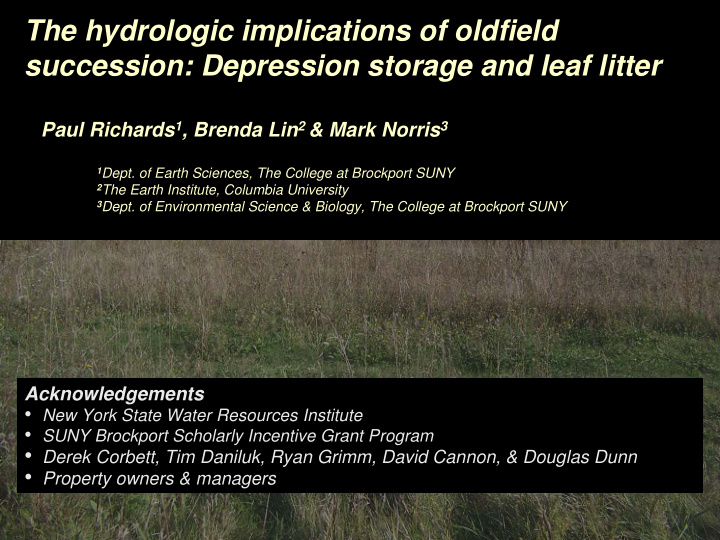



The hydrologic implications of oldfield succession: Depression storage and leaf litter Paul Richards 1 , Brenda Lin 2 & Mark Norris 3 1 Dept. of Earth Sciences, The College at Brockport SUNY 2 The Earth Institute, Columbia University 3 Dept. of Environmental Science & Biology, The College at Brockport SUNY Acknowledgements • New York State Water Resources Institute • SUNY Brockport Scholarly Incentive Grant Program • Derek Corbett, Tim Daniluk, Ryan Grimm, David Cannon, & Douglas Dunn • Property owners & managers
Depression storage Important factor governing water flow in the landscape including: � Erosion potential � Infiltration � Overland runoff Also incorporated as a parameter in several popular hydrologic models: SWMM, WEPP.
Depression storage Theoretical investigations of relationships with: � Roughness � Tortuosity � Slope Abundant field data for crop fields, but very little data for “natural” land uses
Depression storage Ideal storage Effective storage
Vegetation & depression storage During oldfield succession, how does vegetation influence microrelief development? Hypotheses: � Microrelief, depression storage, & plant litter increase over succession � Land use management reduces microrelief & depression storage
Study sites 13 sites representing: • urban grassland • Successional oldfield • Successional shrubland • Mature woodland and • Immature pine forest • Swamp wetland • Forested wetland 3 locations had multiple sites with uniform soils and slopes
Study sites
Methods: Roughness clinometer Used to determine: Slope angle • Slope • Ideal depression storage • Effective depression storage • Tortuosity • Surface roughness
Methods: Roughness clinometer Rough4.exe Available at VORTEX.ESC.BROCKPORT.EDU\~PRICHARD
Methods: Plant cover
Methods: Plant litter
Methods: Plant litter
Plant cover Vegetation survey 7.0 6.0 Granoids 5.0 Forbes 4.0 Shrubs Trees 3.0 Bareground 2.0 Moss 1 .0 0.0 G -5 G -9 G -1 H-1 2 H-4 H-2 H-8 S-1 3 S-6 F-1 1 F-3 F-7 W -1 0 W -1 4 Site ID log (Trees/area) Tree Abundance log (Basal area/area) 0 -1 -2 No No -3 trees trees -4 -5 -6 -7 -8 G-5 G-9 G-1 H-1 2 H-4 H-2 H-8 S-1 3 S-6 F-1 1 F-3 F-7 W -1 0 W -1 4 Northham Rush Campus Northham Swamp Rd Powerline Northham urban Mowed Urban Succ. Emergant Succ. Forest Park Succ. Rush grassland oldfield wetland Verinesi shrubland Rush grassland oldfieldTower urban Tower Honeoye Forested Tower Immature Residential Succ. Falls succ. Succ. wetland Forest Pineforest grassland oldfield oldfield shrubland
RESULTS SUCCESSION
Results Ideal depression storage for all sites 60 Ideal depression storage (mm) 50 40 Oldfield succession 30 20 10 0 Rush Grass ideal NH grass ideal Campus grass ideal Rush Mowed Herb NH herb ideal Tower herb ideal HF herb ideal tower forest ideal NH forest ideal Forest wetland ideal Swamp-ideal
Results
Results 81% increase in effective storage area after 33 years Effective Depression Storage (mm) 6 5 4 mm 3 2 1 0 Rush mowed weeds e Rush Pine Forest e
meadow H N Results Ideal Depression Storage mowed grass H N 16 14 12 10 8 6 4 2 0 mm
oods Tower W Ideal Depression Storage Results Tower shrubland Tower meadow 100 80 60 40 20 0 mm
Effective depression storage for grassland, successional oldfield and forest Normal - 95% CI 99.9 99 95 90 80 70 Percent 60 50 40 30 20 10 Variable 5 All Urban Grass eff All herb eff 1 All forest eff 0.1 -40 -20 0 20 40 60 Effective depression storage (mm)
Effective depression storage-slope relationships
Conclusions � Effective and Ideal Depression storage does increase along the oldfield succession continuimn � Plant litter increases with succession but contributes little to depression storage. � Ideal depression storage values are 5.8, 11.1, 11.4, 14.3 and 22.6 for urban turf, suc. oldfield, suc. shrubland, forest and forested wetland respectively � Mowing appears to retard the natural development of microtopography that occurs during vegetation growth FULL LENGTH MANUSCRIPT AVAILABLE !!!! contact prichard@brockport.edu
Recommend
More recommend